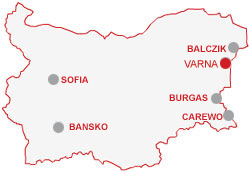Varna
 A district town, situated on Varna Bay on the Black Sea, 469 km north-east of Sofia; a seaside resort. Population of over 350 000. Third in population after Sofia and Plovdiv, called the seaside capital of Bulgaria. Terminal station on the railway lines Sofia-Varna and Rouse-Varna, a sea port, an international airport, second in traffic after Sofia.
A district town, situated on Varna Bay on the Black Sea, 469 km north-east of Sofia; a seaside resort. Population of over 350 000. Third in population after Sofia and Plovdiv, called the seaside capital of Bulgaria. Terminal station on the railway lines Sofia-Varna and Rouse-Varna, a sea port, an international airport, second in traffic after Sofia.
Long sand-covered beach strips.
The gem of the Bulgarian Black Sea is situated at the end of the big Varna Bay, with a convenient and well conserved water area. The city's peculiar sea charm is sublime and moving. Ancient, medieval, renaissance and modern cultures mingle and coexist throughout the city. Varna lies on the same latitude of the famous Atlantic resorts Bayonne and Biarritz in France, on a large, flat and high terrace on the northwestern most curve of the bay which juts some 7 km inland.
During the holiday season, July and August, the sunshine allows 10-11 hours of sunbathing. There is nothing of the cold Baltic wind or the summer Riviera heat. The sea is amazingly calm and free of dangerous tides.
Apart from being a beach resort, Varna rivals the great cities of Sofia and Plovdiv, in its offering of cultural attractions and historical buildings, museums and art galleries. It also provides access to some of the quieter scenic spots along the coast, including the nature reserve of Kamchiya, the royal palace of Balchik and the hillside monastery of Aladja.
Varna is an 'around-the-year' holiday destination. Beyond the high Season its balneotherapy facilities can help you unwind and enjoy the many sights and sounds in peace.
Seaside Park - the biggest park of Varna, situated by the beach. Its construction begins in 1878. Within the park area one can find the Seaside Baths, the Navy Museum, the Museum of Natural History, the Aquarium (unique exposition of water organisms - Black Sea, freshwater, tropical fishes), the Astronomical Observatory and the Planetarium which organizes observation seances for visitors, Dolphinarium with an amusing show, etc. The Church of the Assumption - this church is second in scale after St. Alexander Nevsky Cathedral in Sofia. Erected in 1884-1886 by the master builder Gencho Kunev in honour of the Liberation from Ottoman yoke. Modern Byzantine architecture. Spacious interior, woodcarver iconostasis by masters belonging to the school of Debur, stained glass. The church is painted in 1949-1950. Declared monument of culture.
Evksinograd - a small palace in the vicinity of Varna built for a summer residence of Knyaz Alexander of Battenberg, later used by tzars Ferdinand and Boris III, nowadays - a residence of the government. The construction, started in 1886, the accomplished with the participation of the Viennese architect Rumpelmeyer, the Swiss architect H. Meyer and architect N. Lazarov. The architectural design reminds of the French 18th-century palaces. The building is situated amidst a beautiful park with rare exotic plants.










